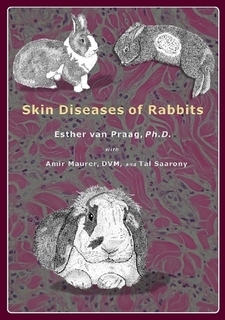Isabelle suffering from sebaceous adenitis
possibly related to a thymoma
Lara Walker
MediRabbit.com is
funded solely by the generosity of donors.
Every
donation, no matter what the size, is appreciated and will aid in the continuing
research of medical care and health of rabbits.
Thank you
|
Warning: this
file contains pictures that may be distressing to some persons
|
House rabbit-English Spot. Spayed female, approx. 7
years old. Adopted from animal shelter and was an adult stray so exact age
unknown. Treating Vet (skin issue): Dr. Sarah Hawklin, DVM at Aptos Creekside Pet Hospital (http://www.aptos-creeksidepets.com/index.pml).
When she dies, her vet will do a necropsy on her. It is expected that she is
going to present Isabelle's case in the near future. Clinical characteristics May
2010-Isabelle was diagnosed with a thymoma. Brought
to vet for exposure of third eyelid. Isabelle has snored when sleeping for
several years but it was starting to get louder. July 2010-Radiation treatment started. 9
doses over 3.5 weeks. In less than a week, she was missing fur around her
eyes and the skin was dry and crusty like elephant skin. The fur was being
removed from her bonded mate and they eventually had to be separated. Her
appetite also gradually declined during radiation treatments and we almost
lost her twice over the summer of 2010. Due to her instability we were unable
to tackle the skin problem and it was spreading from her face to her legs to
her stomach and finally her entire body. It never seemed to bother her but
she developed a strange odor. Sebaceous adenitis was suspected. Once
she started eating better (Sept 2010), we did a biopsy and it was confirmed
that she had SA but there was no known successful treatment so we had to
experiment. To remove the layer of crusty skin, I had
to massage mineral oil into her fur and keep her from licking it for 2 hours.
She was then bathed with a chlorhexidine shampoo. The oil creates a gummy or
pasty substance and all the hair is removed is large clumps. Once the crusty parts were removed, we
tried Heal-X and silvadene, and the spot treatment
of Douxo but none worked so the crusty skin would
reform all over again and she went through the mineral baths 4 times before
we tried the Douxo Seborrhea Micro-Emulsion Spray
by Sogeval. We used it daily as directed and once
her fur grew back, we treated her once/week and then I do spot treatments of
specific spots every now and then. Now that she only get
small spots of crusty skin, I use artificial tears ointment since it is not
as messy as the mineral oil to remove the crust. Once crust is removed, the
spray will work better. I have read an article about thymoma related adenitis in a cat. Once the thymoma was treated in the cat, the skin returned to
normal. This may also be happening in Isabelle's case but the spray works on
the problem sites when it pops up. This
was a very difficult and expensive situation to deal with mostly due to the
treatment of the thymoma. The treatment for the
skin issue is pretty cheap after the biopsy is done. The Douxo
spray lasts a long time and only about $22 per bottle. She still has other
minor issues that pop up (still snores, tiny abscesses, minor sore hocks,
occasional leaking urine) but she is very happy and overall pretty healthy
considering what she has been through. She is also an exceptionally trusting
and tolerant rabbit and I am able to do a lot of her treatments by myself
without any restraint which has been very helpful. For detailed information on sebaceous adenitis in
rabbits, see: “Skin Diseases of Rabbits”, by E. van Praag, A. Maurer and T.
Saarony 408
pages, 2010. Acknowledgements A
special thanks to Isabelle, suffering from sebaceous adenitis. Further reading 1.
Florizoone K. Thymoma-associated exfoliative dermatitis in a rabbit. Vet
Dermatol 2005;16:281-284. 2. Jassies - Van
der Lee A, van Zeeland Y, Kik M, Schoemaker N. Successful treatment of
sebaceous adenitis in a rabbit with ciclosporin and triglycerides. Vet
Dermatol 2009;20:67-71. 3. Quesenberry
KE, Carpenter JW. Ferrets, rabbits and rodents. Clinical Medicine and
Surgery. St Louis, USA: Saunders; 2004. 4. White SD,
Linder KE, Schultheiss P, Scott KV, Page G, Taylor
M, Best SJ, Walder EJ, Rosenkrantz
W, Yager JA. Sebaceous adenitis in four domestic
rabbits (Oryctalagus cuniculus). Vet Dermatol 2000;11:53-60. |
|||||||||||||
e-mail: info@medirabbit.com














